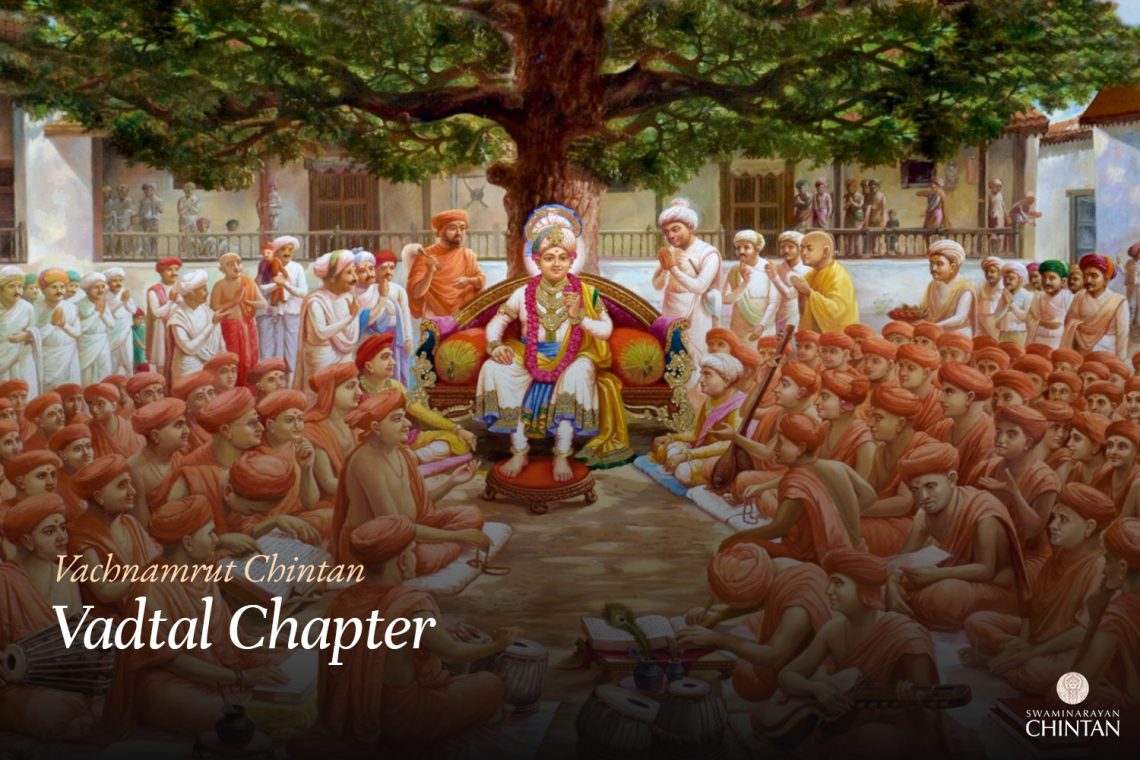Central Insights:
- Nirvikalp Samadhi
Key Points:
- The Nirvikalp Samadhi attained through unwavering conviction in Bhagwan is superior to the Ashtang Yog method of trance.
- A devotee of Bhagwan must wage a war against the mind, as it will certainly lead to their ultimate good.
Explanation:
In this Vachanamrut, Shobharam Shastri from Vadodara asked Maharaj, “O Maharaj! When a mumukshu (seeker of liberation) attains Nirvikalp Samadhi, they transcend the gunas (attributes of Maya) and become an Ekantik Bhakt (single-minded devotee of God). But what happens to someone who cannot attain Nirvikalp Samadhi?”
Maharaj replied, “It is not necessary for Nirvikalp Samadhi to occur only through the control of Pran (breaths of life). There is another way to attain Nirvikalp Samadhi. Listen as I explain it. The Nirvikalpta (absolute state) that leads to the realization of Bhagwan is distinct. When one attains unwavering conviction in Bhagwan, they become an Ekantik devotee. However, even if one continuously practices Samadhi through the control of Pran, it does not necessarily bring about Ekantikta (single-minded devotion). Nor does it eliminate the inner vikalp (doubts and delusions).”
Here, Maharaj contrasts two types of Nirvikalp Samadhi: one achieved through the Ashtang Yog method, and the other through the direct and unwavering conviction in Bhagwan — Shreeji Maharaj. To become an Ekantik devotee, and to serve Bhagwan in His divine abode, the means is through Nirvikalp nishchay (unwavering conviction), rather than the Samadhi attained by controlling Pran. The latter does not serve as a method for gaining Bhagwan’s service or achieving Ekantikta. The Nirvikalp nishchay type of Samadhi is the realization of Bhagwan’s true form, where no doubts should exist. If one has unwavering conviction, it is superior to Nirvikalp Samadhi attained through Pran control because its attainment is higher.
If even through Ashtang Yog one has doubts or conflicting thoughts about the manifest Bhagwan — Shreeji Maharaj, or lacks firm conviction, those doubts are not resolved. On the contrary, Maharaj says that without conviction, even during Samadhi, the person may desire to see new visions. This will prevent them from experiencing contentment and fulfillment with the manifest form of Shreeji Maharaj. In contrast, Nirvikalp nishchay brings about a sense of complete fulfillment in the form of Bhagwan. Therefore, the significance of unwavering conviction on the path of liberation is immense, and the results it brings cannot be achieved through Pran-controlled Samadhi. Maharaj explains the process of Nirvikalp nishchay in this Vachanamrut.
अत्र सर्गो विसर्गश्च स्थानं पोषणमूतयः।
मन्वन्तरेशानुकथा निरोधो मुक्तिराश्रयः।।
Atra sargo visargaśca sthānaṃ poṣaṇam ūtayaḥ |
Manvantarēśānukathā nirodho muktir āśrayaḥ ||
(Shrimad Bhagwat 2/10/1)
These ten characteristics are said to be the functions of Bhagwan. By recognizing the nine characteristics, one should take refuge in Bhagwan. These ten characteristics describe Bhagwan’s actions as follows:
- Sarga – Shreeji Maharaj is the creator of this entire universe.
- Visarga – He is also the creator of all intermediary beings and the five elemental creations.
- Sthāna – Bhagwan has established places within the universes to protect His devotees.
- Poṣaṇa – Bhagwan nourishes and sustains the mumukshu, divine beings, and devotees in the universe.
- Ūtayaḥ – Bhagwan bestowers the fruits of each soul’s based on thier vasanas (inherent desires), rewarding the good (e.g., Prahlad) and punishing the wicked (e.g., Hiranyakashipu).
- Manvantara-kathā – Through different Manvantaras, Bhagwan establishes Dharma.
- Īśānukathā – Stories of incarnations and manifestations of God.
- Nirodha – The restraint of the mind in Bhagwan’s divine lila (pastimes).
- Mukti – Bhagwan, as the destroyer of the universe, grants liberation to His devotees.
- Āśraya – Taking refuge in such a Bhagwan grants fulfillment in both this world and the beyond.
When one understands this auspicious form of Shreeji Maharaj, they develop unwavering conviction, which is unshakable. Even in any kind of difficulty or internal conflict, one remains steadfast in their conviction that Maharaj is indeed the one true Bhagwan. Whether one encounters illness or hardships, and even if Bhagwan does not immediately deliver them from those challenges, their conviction should not waver. In such a state, one experiences a steady, unwavering resolve in their heart. This is what constitutes Nirvikalp conviction, and it is superior to the Samadhi of Ashtang Yog, as it leads to ultimate liberation.
Then, Dinanath Bhatt asked, “If someone tries to dispel conflicting thoughts about Bhagwan but fails to control their mind, what happens to them?”
Maharaj gave the example of the war between the Kaurav and Pandav and explained, “If a devotee of Bhagwan fights the battle with their mind, they will attain Nirvikalp state. Even if they lose the battle, they will become a Yogbhrashta (fallen Yogi), and in the end, they will attain Bhagwan. Thus, waging a war with the mind is always beneficial for a devotee, and they should never give up this effort. Therefore, a wise person should always consider their mind an enemy and engage in this battle for their ultimate good, as it pleases Bhagwan.”
Glossary
| Nirvikalp Samadhi – A state of perfect absorption or concentration where the mind is undisturbed It is a state of meditation where the individual’s mind is fully absorbed in the object of meditation, without any distractions, and free from worldly attachments. |
| Ekantik Bhakt – Single-minded devotee |
| Nirvikalp Nishchay – Unconditional faith Faith that is free from bodily identification and based solely on spiritual understanding. |
| Pran – Vital energy The life force that is nourished by food and interacts with the senses, bringing impurities when uncontrolled. |
| Vikalp – Doubts and delusions |
| Manas Yudh – Battle of the mind |
| Ashtang Yog – Eightfold yoga |
| Mumukshu – Seeker of liberation (Moksha) |
| Guna – Attributes of Maya |

